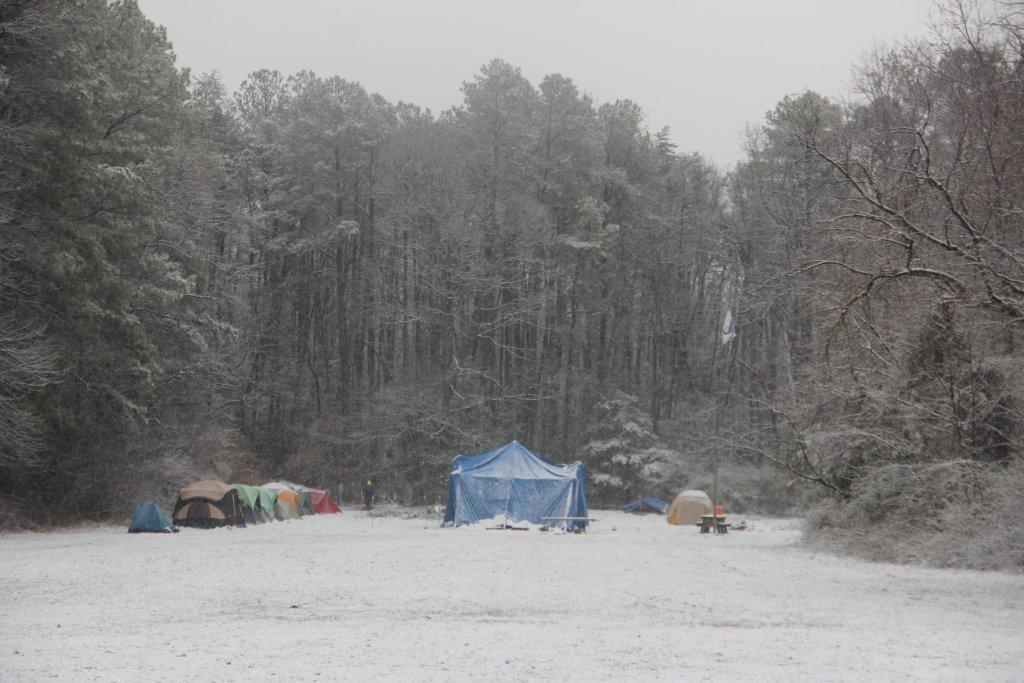
Tufts Sailing Camping
Each year, the Tufts Sailing Team checks the forecast, packs their bags, and drives south to North Field—which is, literally, a field. It belongs to St. Mary’s College of Maryland and is home to a dilapidated barn, St. Mary’s rugby team practices, and—for one week each year—the Jumbos. After surviving four years on the field, I now feel qualified to share some pointers for anyone aspiring to camp while simultaneously training hard for their spring season.
The first rule on the field is show up on time. Show up on time for breakfast, or you’ll miss any hot food that might have been made. Get to the boathouse and be dressed and rigged by 0900, or suffer the consequences. If you require coffee in the mornings, then leave the field by 0830 and make a run to the Campus Center. Even more vital to your well being than being on time for breakfast is being punctual to dinner, unless you’re trying to shed winter weight. A moving target, dinner is served whenever it’s ready, and if you’re not also ready, you go hungry. In the wilderness, everyone switches to survival mode; you’ve got to look out for yourself. So have your bowl ready and your fork in hand.
On the flip side, the next rule is you must work together to survive. In order to function in the wild, everyone needs to pull his or her own weight. This means that while a handful of people are cooking dinner, everyone else gathers and chops wood for the fire. Food must be inventoried each day, and the group that has the afternoon off has to go to Walmart to restock rations and supplies. If that group doesn’t buy enough food, the team goes hungry, and you’ll have a lot of angry Jumbos with empty bellies.
Before you even get to North Field, chances are good that you’ll stop at Walmart. There, first-timers are responsible for buying their own camp chairs (everyone else’s are stored in the old barn, along with some basic cooking and camp equipment), and everyone goes hard on the camo selection. Proper clothing is of paramount importance to survival. A “Spring Break Jacket” can be found in the back of your closet, at GoodWill, or at Walmart. It should be weatherproof, hooded, and not missed if it dives into the fire on the last night. Aside from your outer layer, bring as much fleece as possible—onesies are incredibly warm and also stylish. Do be aware that everything you wear around the campfire will leave North Field with burn holes in it, so don’t bring that new Patagonia. Bring two hats: one for sailing, and one for sleeping, as most nights you will be sleeping as bundled up as humanly possible.
That leads me to the next vital topic: sleeping arrangements. The most hardcore sleep in hammocks, on the ground, or on thin sleeping pads. The rest of the team brings air mattresses (don’t forget pump batteries!), sleeping bags rated to the coldest temperature possible, and (hopefully) waterproof tents. Because when it rains, it pours, and when it pours, your tent might flood. A light for the tent is a good idea, but more important is a solid headlamp. The headlamp will be your main source of illumination during the night, and you’ll need it for any forays away from the campfire.
Aside from basic lighting and an air mattress pump, leave your electronics at home. “Trade your alarm clock for birds singing, your computer screen for stars and planets, electric heat for a massive campfire, Facebook for real friends, and your telephone for a game of telephone,” said Tufts coach Ken Legler, who has weathered 20 years in the tents. You can charge your phone at the boathouse if you must, but being able to put it away and leave the social network we’re all constantly entangled in can actually be surprisingly soothing.
Sometimes, the entire team might come down with a horrible plague. I don’t have any real advice for that besides wash your hands and don’t use the sole Porta Potty. If stricken, the St. Mary’s Seahawks will likely allow the victims to curl up upstairs in their beautiful boathouse until the worst passes, and the campus center can provide saltines and Gatorade. Embrace the experience, and try to let go of the pain.
Finally, in preparation for The Field, plan some entertainment. Everyone around the campfire must hold the floor for about five minutes, either by themselves or in small groups. Entertainment can consist of songs, games, dances, stories, skits, snacks, or other various activities, but should leave a smile on everyone’s face.
Even though you might be sailing in the rain—and sleeping in the rain—the campfire can burn off all but the worst of the deluge. After the bitterest of nights, walking outside to a magical tent city covered in snow can be enough to soothe memories of shivering to stay warm, and the sun looks that much more beautiful after it’s been hidden away. The lessons that North Field teach you stick with you long after the last van pulls away—avoiding the muddiest patches for fear of getting stuck—and the bonds you forge with your teammates cannot be replicated in a Hilton, Quinta, or Holiday Inn.









